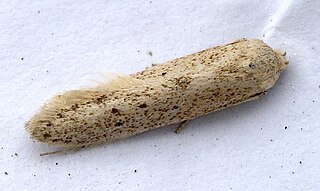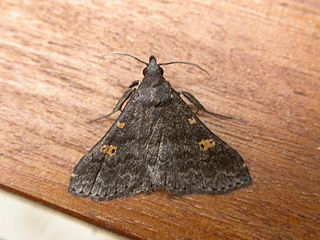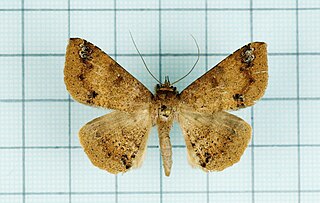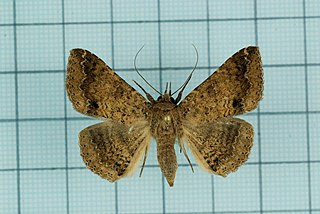
Copromorphidae, the "tropical fruitworm moths", is a family of insects in the lepidopteran order. These moths have broad, rounded forewings, and well-camouflaged scale patterns. Unlike Carposinidae the mouthparts include "labial palps" with the second rather than third segment the longest. With other unusual structural characteristics of the caterpillar and adult, it could represent the sister lineage of all other extant members of this superfamily. The genus Sisyroxena from Madagascar is also notable for its unusual venation and wing scale sockets.

The Calpinae are a subfamily of moths in the family Erebidae described by Jean Baptiste Boisduval in 1840. This subfamily includes many species of moths that have a pointed and barbed proboscis adapted to piercing the skins of fruit to feed on juice, and in the case of the several Calyptra species of vampire moths, to piercing the skins of mammals to feed on blood. The subfamily contains some large moths with wingspans longer than 5 cm (2 in).

The Archipini are a tribe of tortrix moths. Since many genera of these are not yet assigned to tribes, the genus list presented here is provisional.

Blastobasis is the type genus of the gelechioid moth family Blastobasidae; in some arrangements these are placed in the case-bearer family (Coleophoridae) as a subfamily. Within the Blastobasidae, the subfamily Blastobasinae has been established to distinguish the Blastobasis lineage from the group around Holcocera, but the delimitation is not yet well-resolved.

Naarda is a large genus of erebid moths currently encompassing 108 species. Initially identified by Francis Walker in 1866, it is in the family Erebidae. Somewhat ruddy in appearance, this genus is distinguishable for its generally slender thorax and abdomen, and straight, porrect labial palpi. Most species are a light tan color, but shading can reach as deep as a charcoal, with muddy yellow, conspicuous reniform, orbicular stigmata featured on the forewings, sometimes reflected bilaterally superior.

Ericeia is a genus of moths in the family Erebidae. The genus was erected by Francis Walker in 1858.

Porela is a genus of moths in the family Lasiocampidae. The genus was erected by Francis Walker in 1855. All species are known from Australia.

Macrobathra is a genus of moths in the family Cosmopterigidae. Most species are endemic to Australia.

Ericeia subsignata is a moth of the family Erebidae. It is known from Australia, including the Australian Capital Territory.

Ericeia inangulata, the sober tabby, is a moth in the family Erebidae. The species was first described by Achille Guenée in 1852. It is found in the Indo-Australian tropics of China, India, Sri Lanka, Myanmar, and the Marianas and Carolines, Fiji, Vanuatu, New Caledonia and Samoa.

Ericeia pertendens is a moth in the family Erebidae first described by Francis Walker in 1858. It is found from the Indo-Australian tropics to the Solomon Islands.
The Hulodini are a tribe of moths in the family Erebidae.
Ericeia sobria is a moth in the family Erebidae. It is found in Kenya, South Africa, Gambia, Borneo, New Guinea and Australia, where it has been recorded from Queensland and New South Wales.
Ericeia fraterna is a moth in the family Erebidae. It is found in China, India, Burma, Sri Lanka, the Philippines (Luzon) and Indonesia.
Ericeia goniosema is a moth in the family Erebidae. It is found in New Guinea and Australia, where it has been recorded from Queensland.
Ericeia hirsutitarsus is a moth in the family Erebidae. It is found on Norfolk Island, New Caledonia, Vanuatu, the New Hebrides and the Loyalty Islands.
Ericeia leichardtii is a moth in the family Erebidae. It is found on Fiji, Tonga, the Loyalty Islands Samoa and in northern Australia.
Ericeia pallidula is a moth in the family Erebidae. It is found in Indonesia (Buru).
Parallactis plaesiodes is a moth in the family Autostichidae. It was described by Edward Meyrick in 1920. It is found in Kenya, Mozambique and South Africa.










